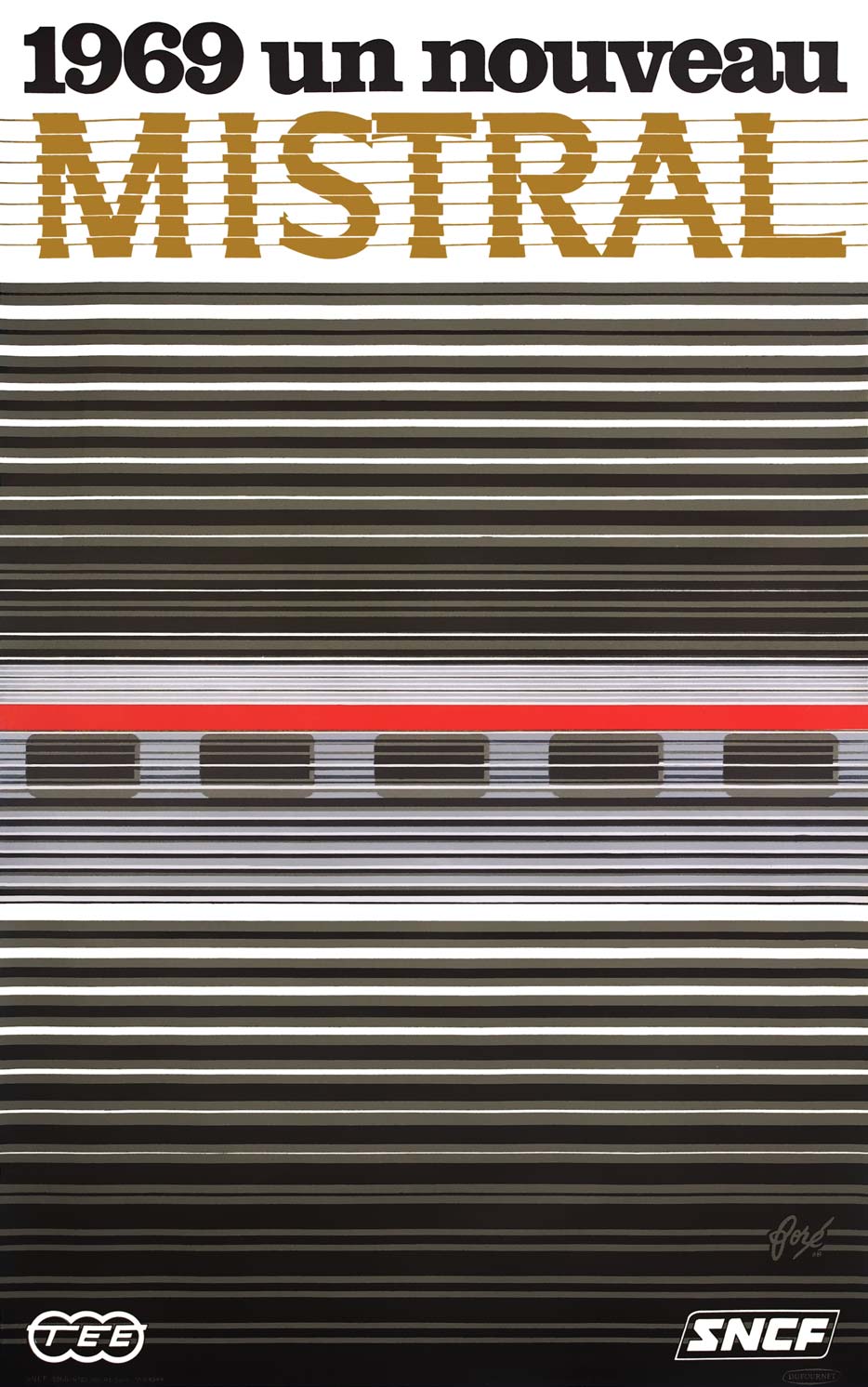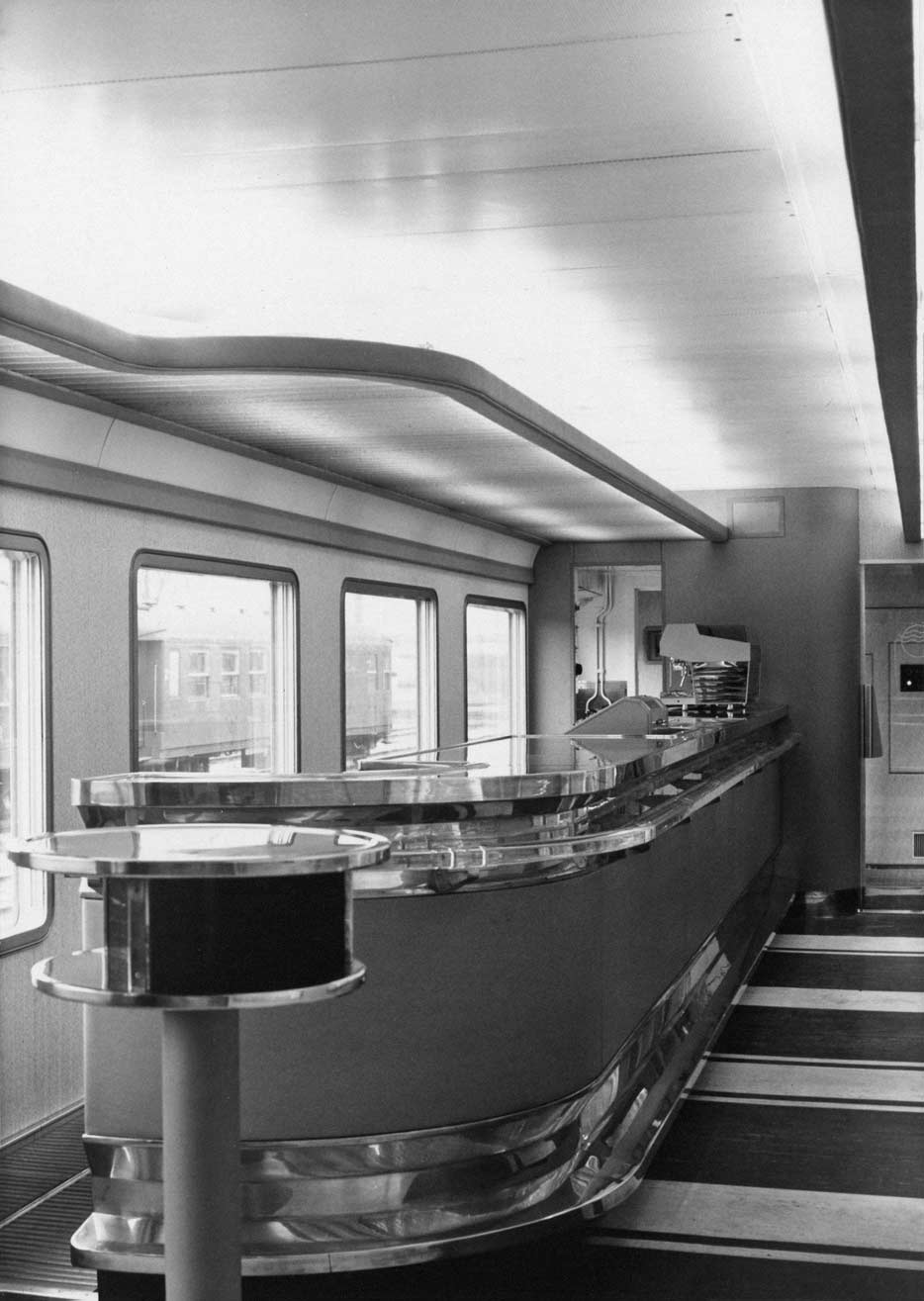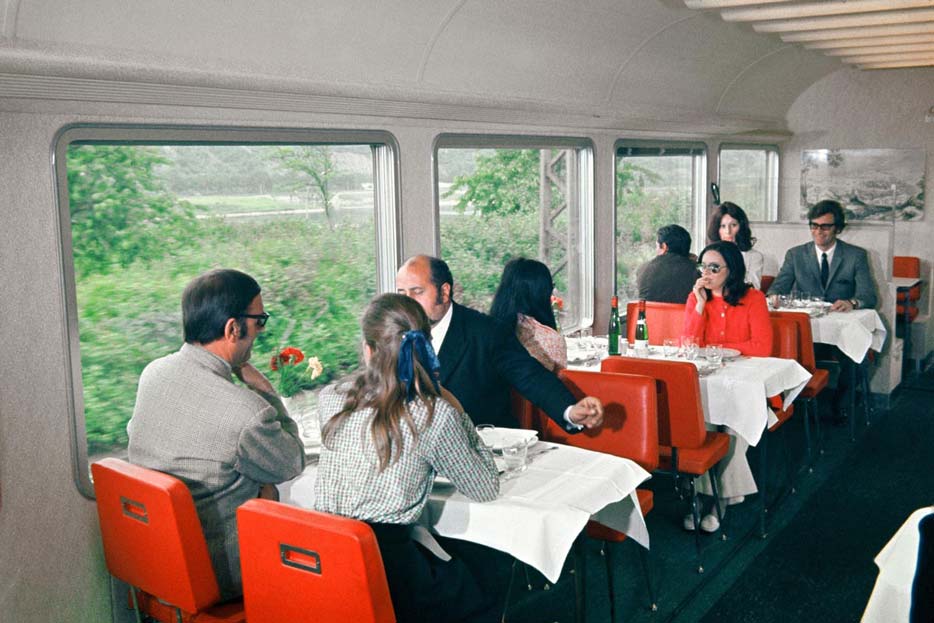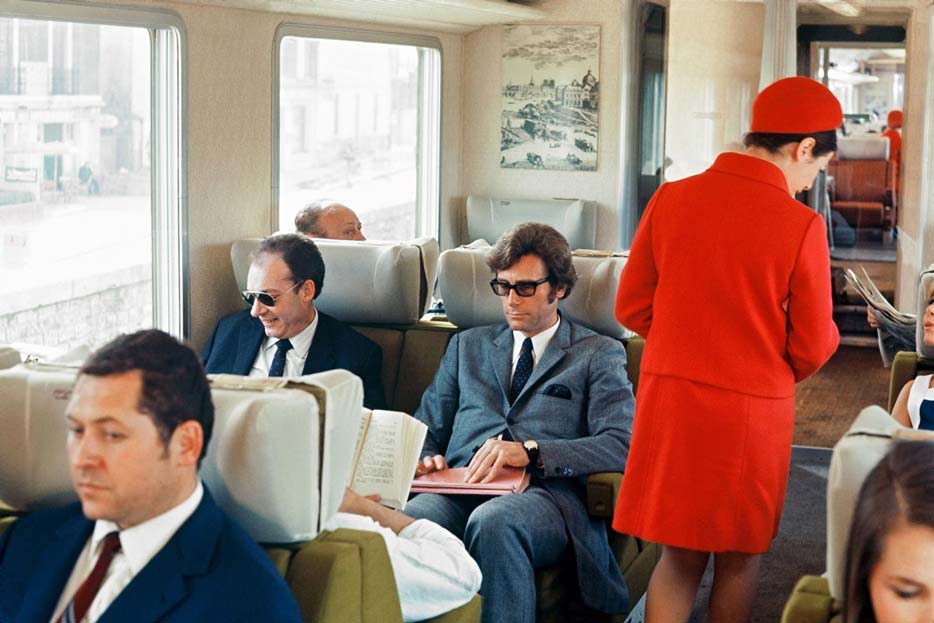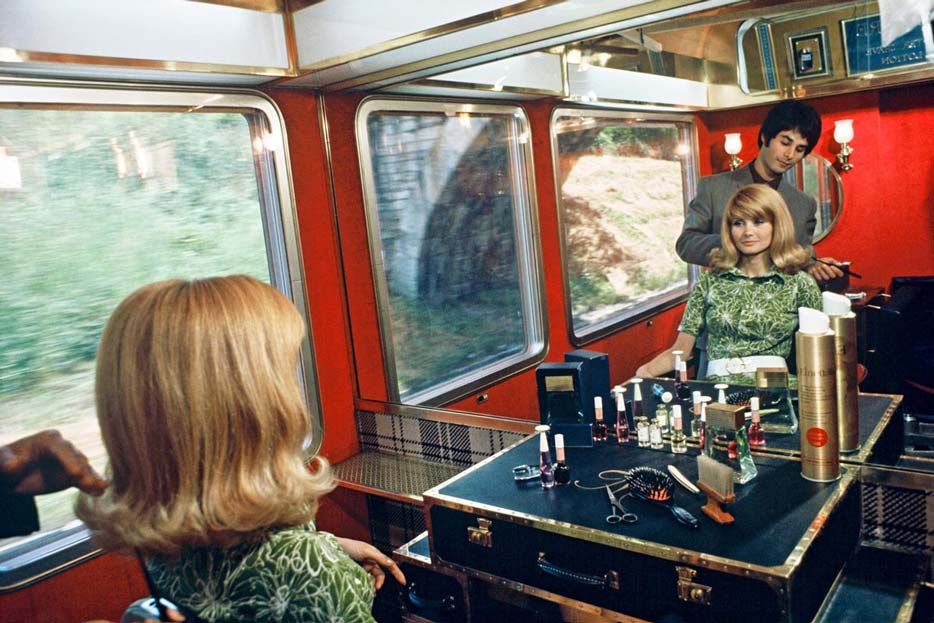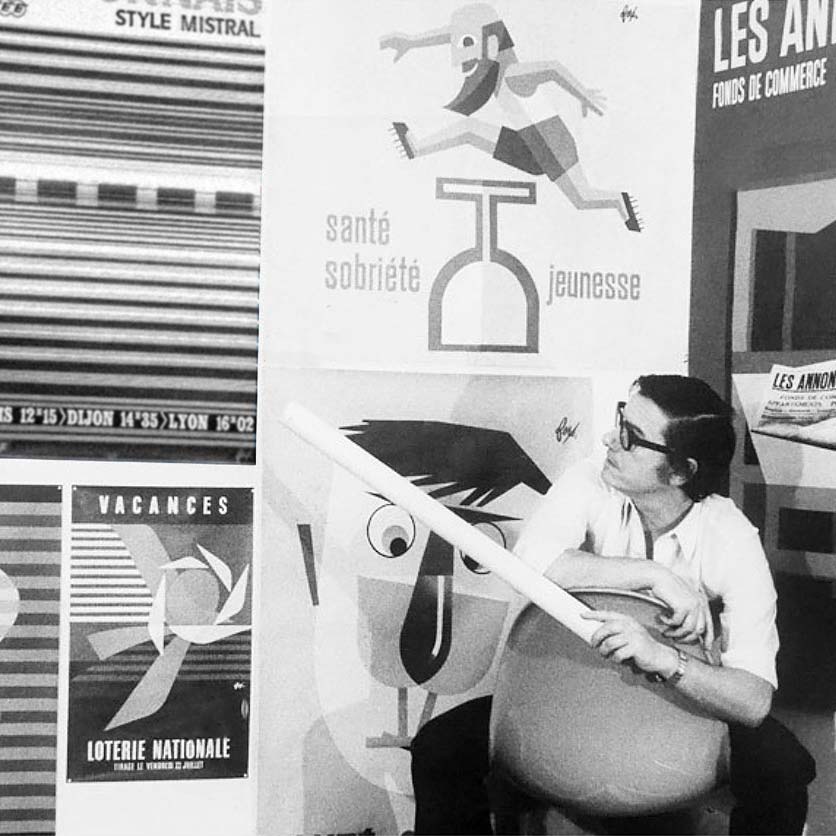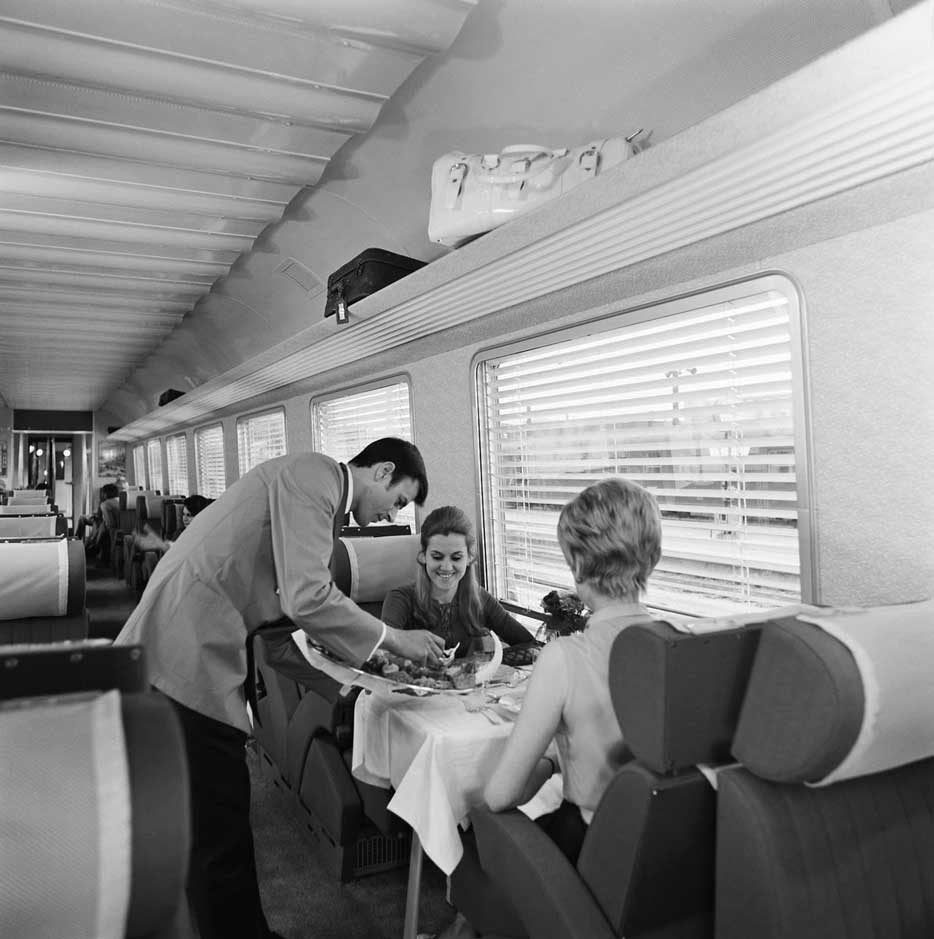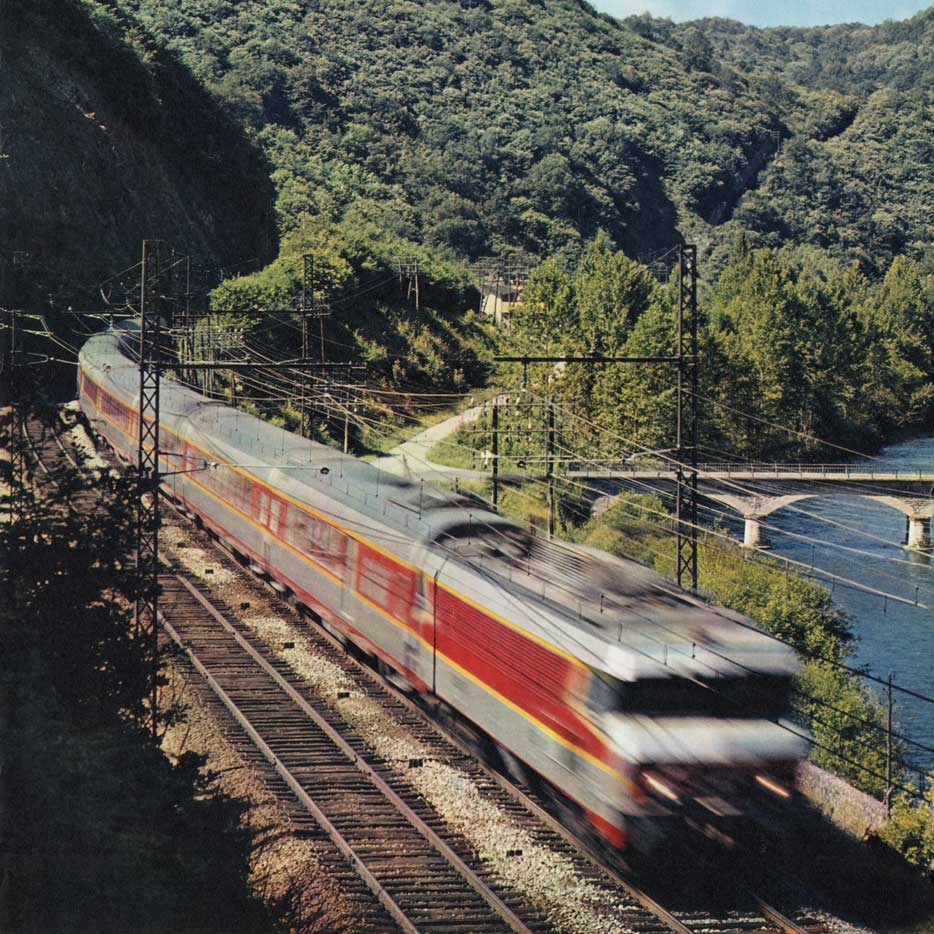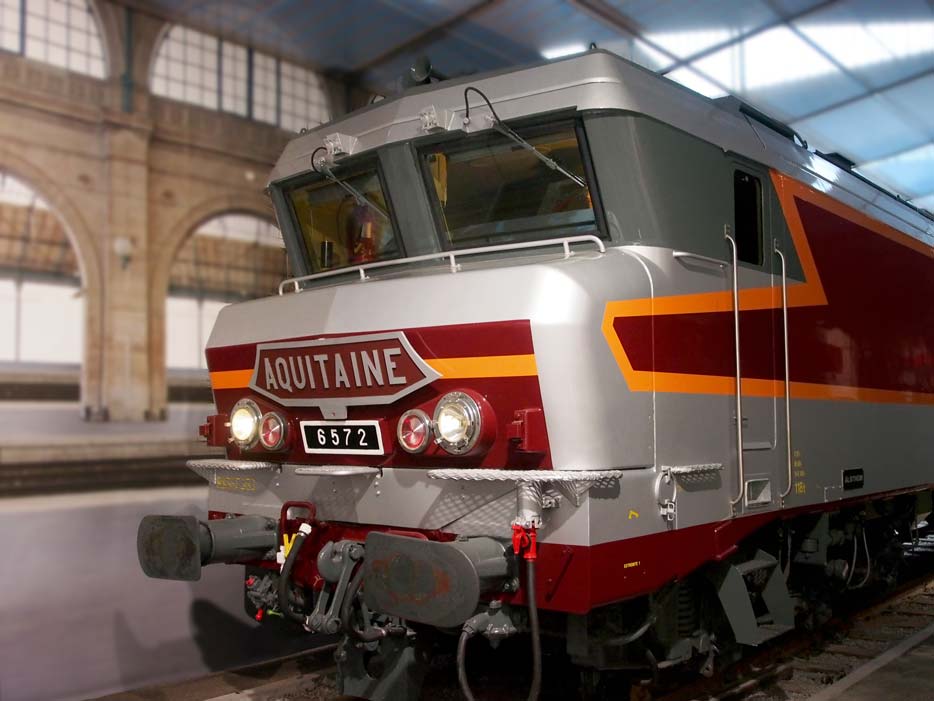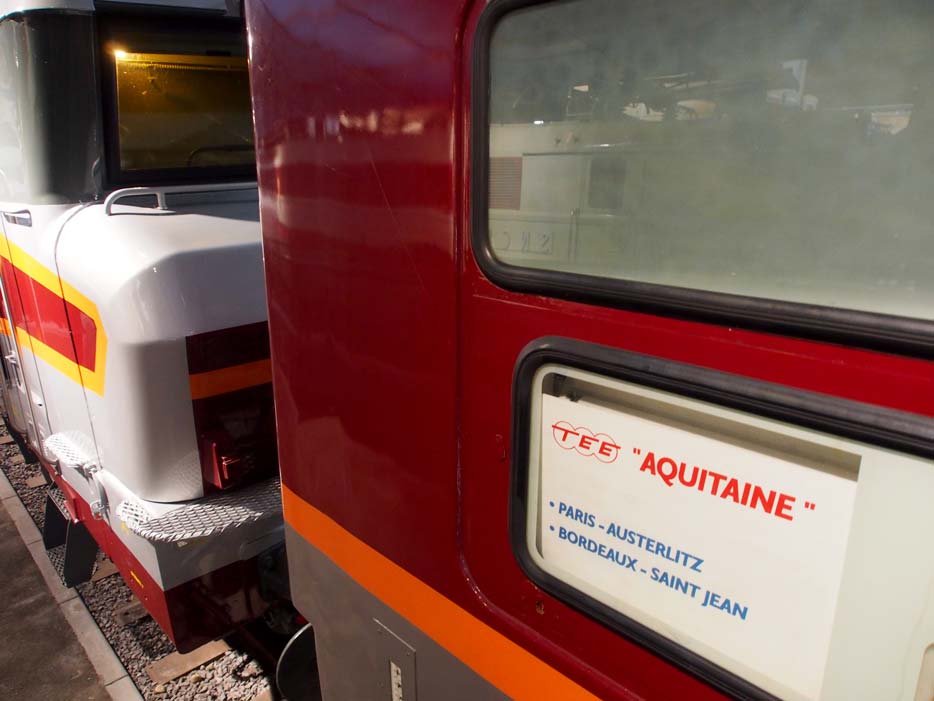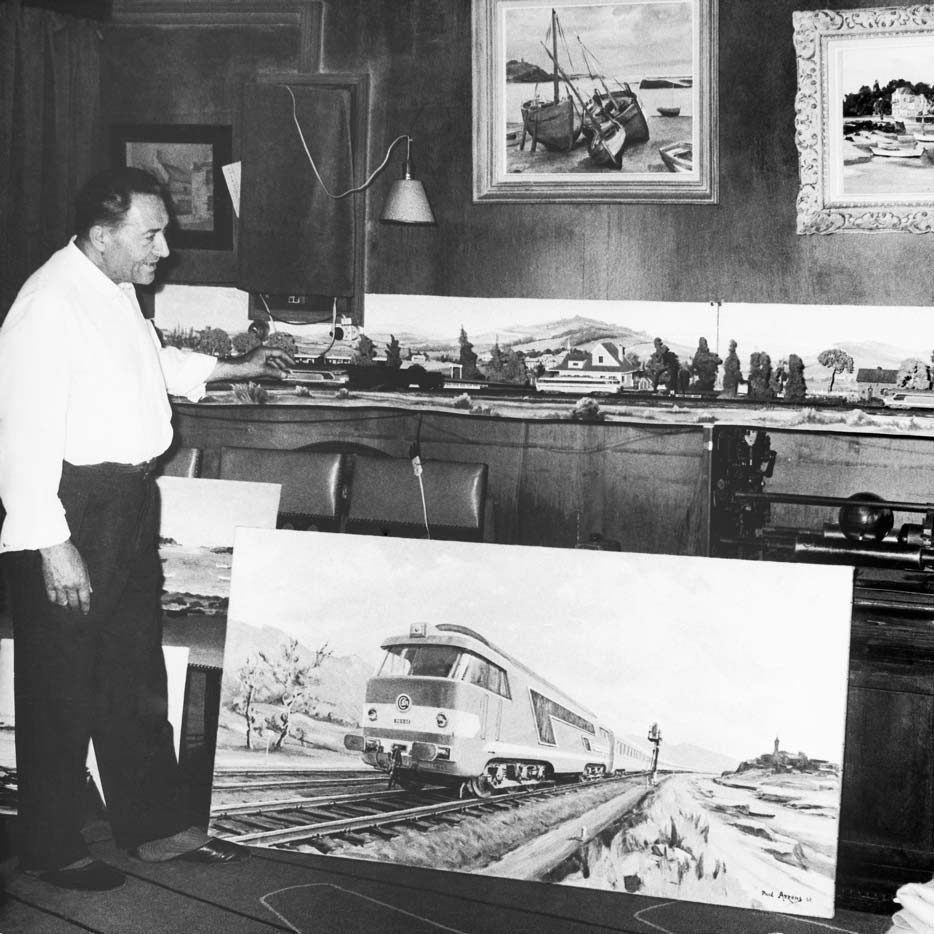Inox et Grand Confort
French TEE carriages and posters around 1970
 Nederlandse versie
Nederlandse versie
In the late 1960s domestic long-distance trains were added to the Trans Europ Express (TEE) network of first-class trains. Paul Arzens designed colorful TEE carriages and sharp-cut locomotives for the French national railways.
Matching posters for these SNCF carriages were created by graphic designer Philippe Foré. He played with lines and colors to express speed and strength. The posters promoted legendary trains such as the Mistral and Capitole.
Le Mistral
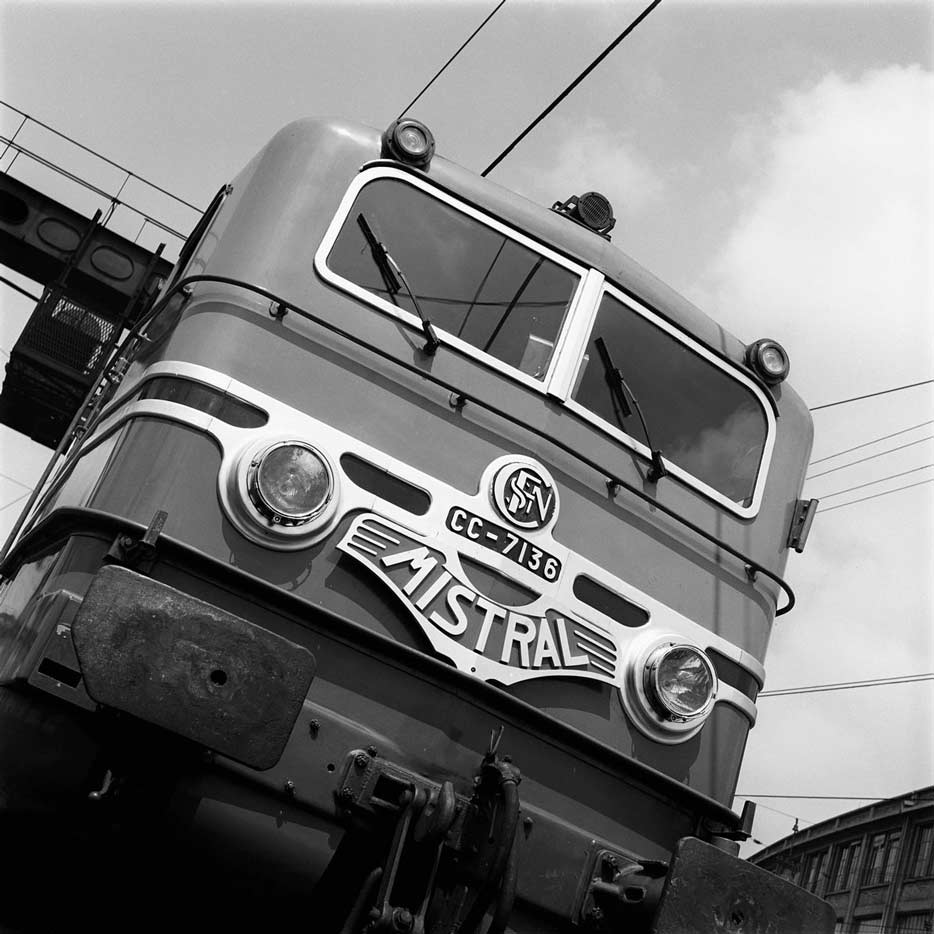
In 1950 the SNCF started a fast train from Paris to Marseille with first-class seats only. It was named Le Mistral after the wind blowing from the northwest to the Mediterranean. In 1952 its route was extended to Nice. For a long time the Mistral was the fastest regular train service in the world. Originally hauled by steam, the train's speed increased further as electrification progressed. It reached Lyon in 1952 and Marseille ten years later. The 861 kilometers were covered in around 7 hours (an average of 120 kilometers per hour), almost 2 hours faster than in the early years.
The Mistral was usually hauled by a CC 7100 locomotive, which had set a speed record of 331 kilometers per hour in 1955. These locomotives were built by Alsthom between 1952 and 1955 according to a design by Paul Arzens.

'This beautiful two-toned-green locomotive, trimmed with chrome lines and splashes of red, wheels an express that typifies elegance as well as speed', Freeman Hubbard wrote about the Mistral in Railroad Magazine in 1962.
The carriages certainly contributed to the elegant appearance. In 1956 the Mistral was equipped with streamlined stainless steel carriages, called Inox (acier inoxydable) in French. These were deluxe versions of the steel DEV coaches that the SNCF was using since 1950. The French Inox carriages were inspired by American 'streamliners'. The Mistral 56 series consisted of two types: a five-compartment bar car and eight-compartment coaches. There were no Inox dining cars because Wagons-Lits carriages were added to the Mistral for this purpose.
Un nouveau Mistral
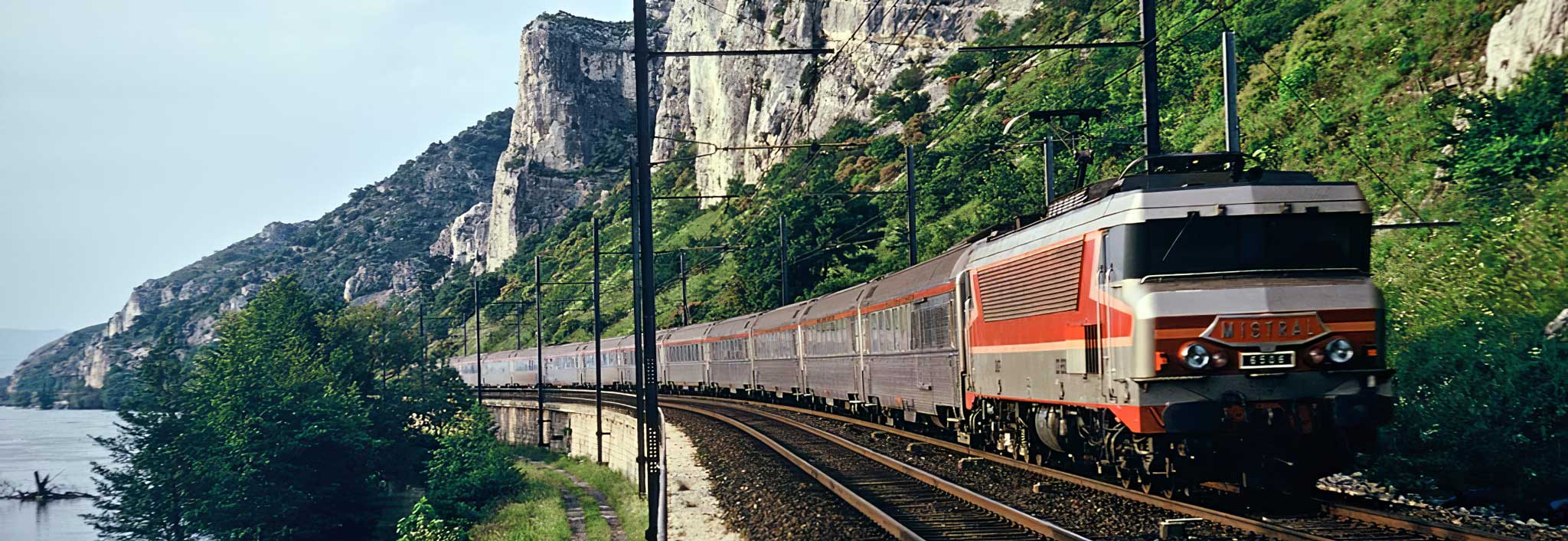
In 1965 the international criterion was abandoned for the Trans Europ Express (TEE), a network of first-class day trains linking over 100 European cities, which had started in 1957. Domestic long-distance trains were added to the TEE network, the Mistral being one of the first in France. The existing Inox coaches were fitted with a red band with a Trans Europ Express inscription.
In 1969 it was time for un nouveau Mistral with new, even more luxurious Inox coaches. These were based on the PBA type carriages that were introduced in 1964 for the TEE service on the Paris-Brussels Amsterdam (PBA) route. The new train composition also had an Inox restaurant car and a service car wit bar, kiosk, hairdressing salon and a secretary service where businessmen could dictate letters and telegrams. A characteristic detail of the carriages were the horizontal blinds between the double glazing of the windows.
Philippe Foré created a poster for the Nouveau Mistral featuring the distinctive horizontal Inox ripples. Foré later described the process of conceiving the poster: 'I was in the train, looking out of the window. All was cut into stripes. The sun projected the shape of the windows. All broke down into lines while the train was speeding ahead. The idea came to me to translate this visually into bands. That's how the Mistral poster was born.'
Style Mistral
A few years later two additional domestic TEE trains switched to the 'style Mistral' using new Inox coaches: Le Rhodanien and Le Lyonnais. The former was the evening train from Paris to Marseille, while the Mistral ran during daytime. The Rhodanien started in 1964 as an international train between Geneva and Marseille, named after the Rhone Valley through which the railway runs. In 1971 the Rhodanien became part of the TEE network. It was fitted with Mistral 69 coaches and the northern terminus shifted from Geneva to Paris.
The Rhodanien's travel time from Paris to Marseille was only 6.5 hours. Another luxury express train ran along the first 500 kilometers of the same route, up to Lyon: the Lyonnais, named after the geographical region around Lyon. The train only stopped in Dijon on the outbound journey from Paris; passengers who wanted to return to Dijon from Lyon in the evening could use the Mistral. When introduced in 1968 the Lyonnais was using 'discarded' Mistral 56 coaches; upon becoming a TEE service it switched to the new Inox coaches.
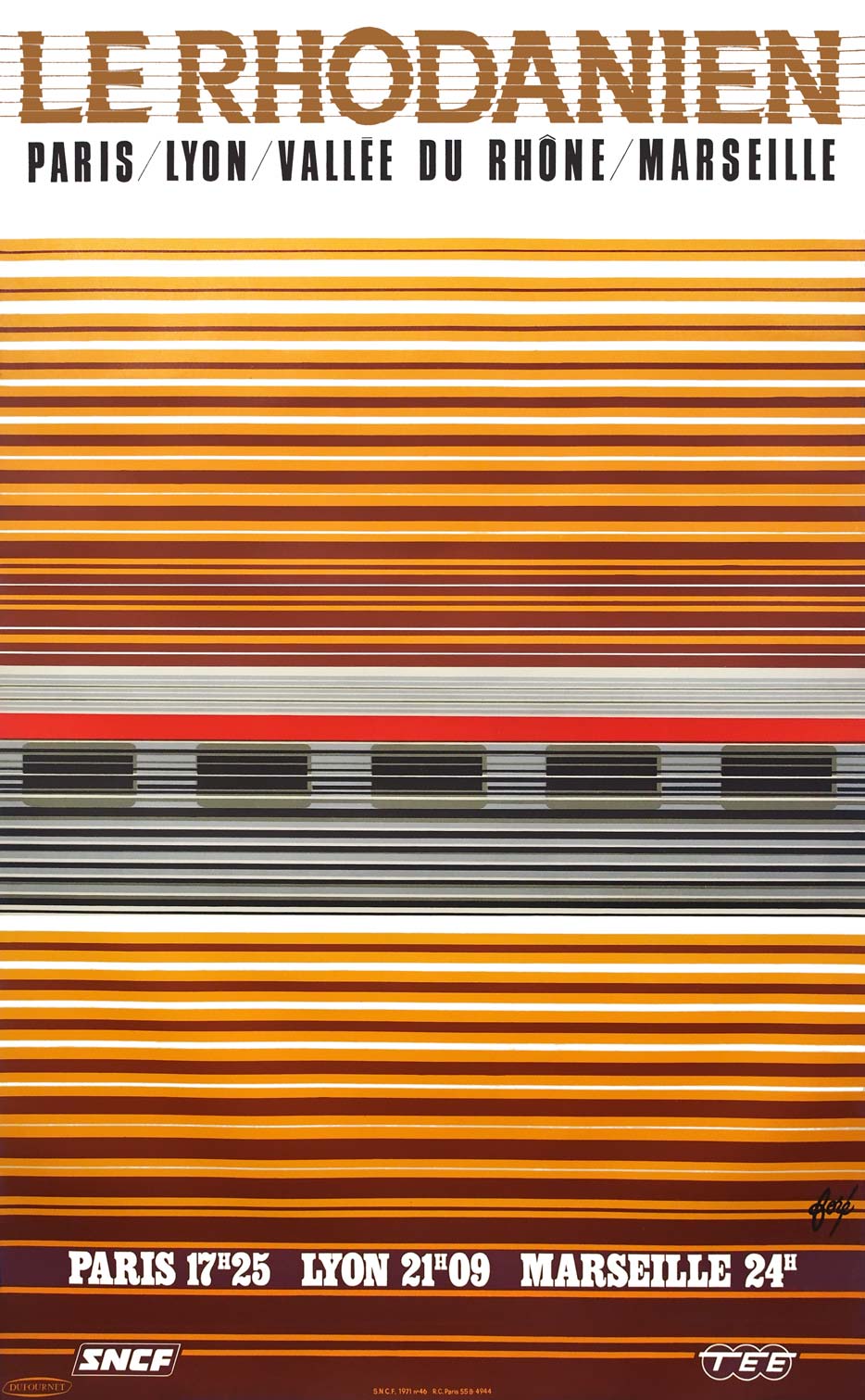
Philippe Foré designed altered versions of his Mistral poster for the two other 'style Mistral' TEE trains. An orange-striped edition was issued for the Rhodanian and a blue-toned version for the Lyonnais. While the Mistral original was presented at the Third International Poster Biennale in Warsaw, the Lyonnais version won several awards, including a Sirène d'Or at Milan and the Prix National de l'Affiche of April 1970.
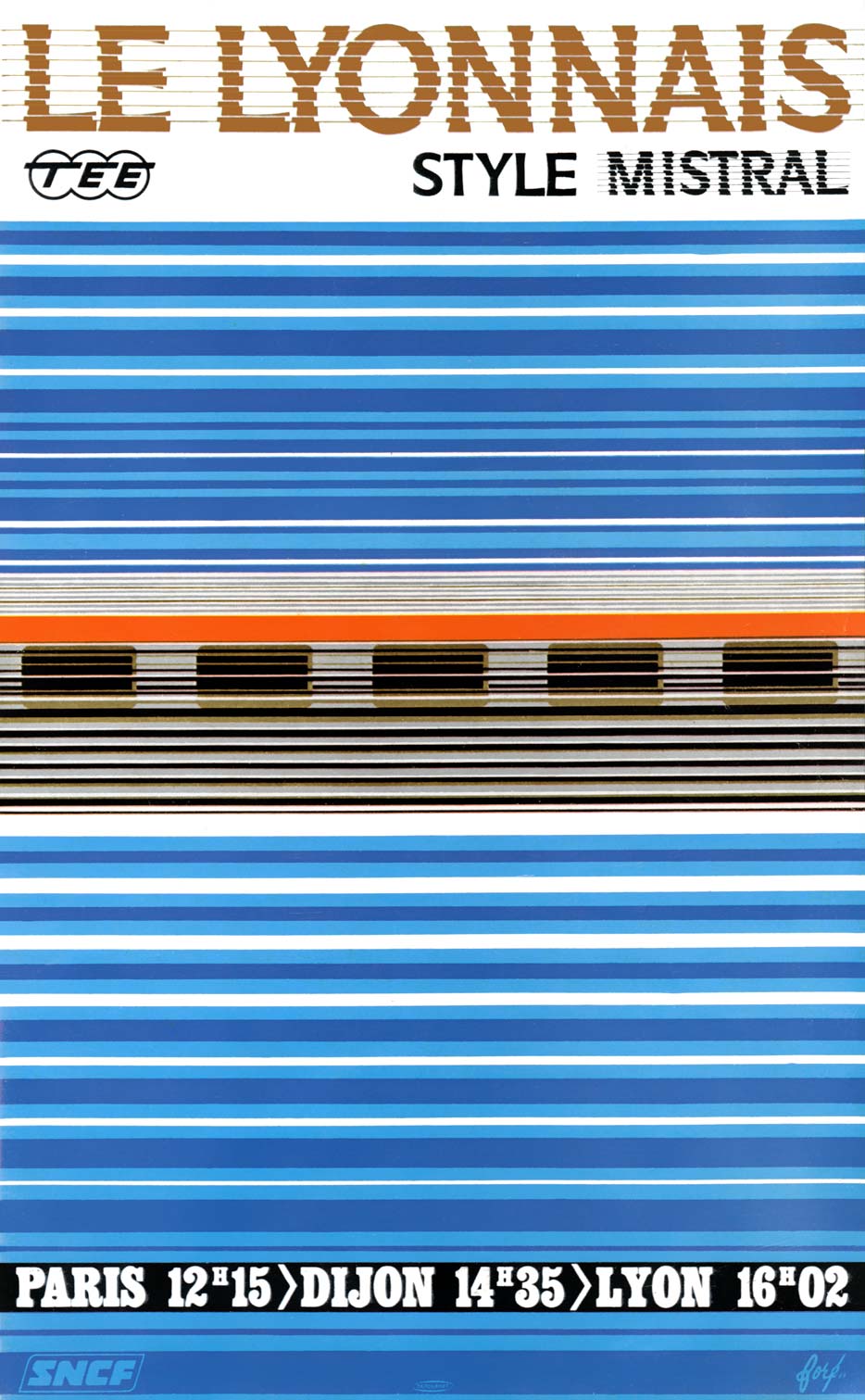
According to the jury report: 'This work of Foré has determined the choice of the jurors by the sobriety of its form and the quality of its interpretation. The jury considers it remarkable for the use of parallels without changing the perspective of the abstracted train. The designer has played with lines and colors to express speed and strength.'
The Rhodanien and Lyonnais also had a dining car and a service carriage with all kinds of facilities. An SNCF leaflet stated: 'Dans le Lyonnais vous trouverez les mêmes services que dans le Mistral: boutique, secrétariat, salon de coiffure pour hommes et dames, et bien entendu bar, restauration et aussi des hôtesses qui accompagnant le train pendant tout le voyage.' The predominant color for all these services was red: the synthetic leather chairs in the dining car, the walls of the hairdressing salon as well as the capes of the hostesses.
Philippe Foré
Philippe Fauré (1927-2018) was from the Midi-Pyrénées region and studied design at the École des Beaux-Arts in Toulouse. After moving to Paris he would become one of the most prolific French poster designers, working for cosmetics and fashion companies. For better legibility Fauré simplified his name and signed his posters with foré only. He created the first of many posters for the French Railways in 1958, cartoonishly depicting a traveling family.
By the end of the 1960s his posters became more abstract. His style, soon called 'lignisme', was based on the dynamics of parallel lines at variable spacing, sometimes combined with curves or gaps, all intended to express movement and speed. He was inspired by kinetic art and cinematographic framing. His favorite medium was gouache because it allowed easy retouching.
Le Capitole
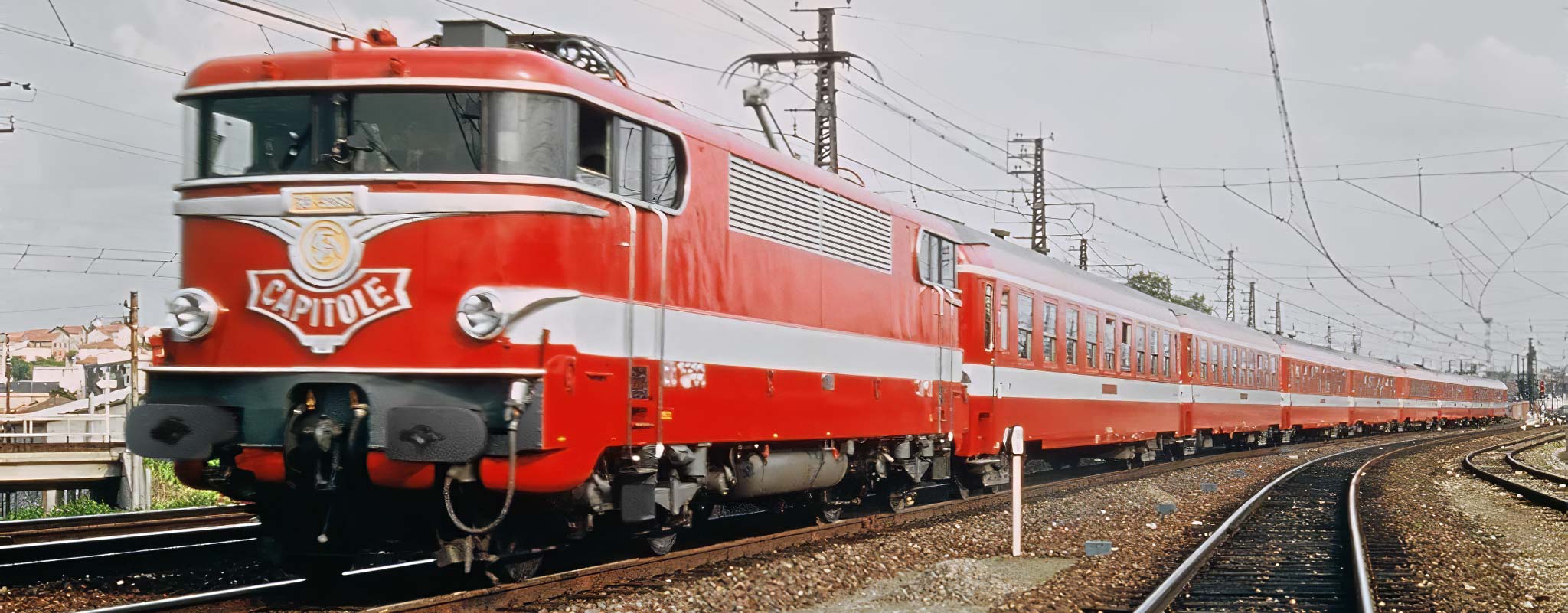
Another legendary French train that became a domestic TEE around 1970 was Le Capitole. This luxury express train connected Paris to Toulouse and was named after the Capitole de Toulouse, the historic heart of the city with the Opera and City Hall.
The Capitole started in 1960 with first-class Inox 56-type coaches. The 700-kilometer stretch was completed in exactly 7 hours, but travel time further decreased when special Capitole rolling stock was developed for speeds up to 200 km/h. Six BB 9200 locomotives were altered for high speed. They were equipped with a single pantograph that was more resistant to speed than regular double (diamond-shaped) pantographs. The new carriages (UIC-Y type) were also adapted for speed. Both the locomotive (nicknamed BB rouge) and the carriages were given a red livery with a white band, specific to the Capitole.
In 1967 a timetable speed of 200 km/h was actually achieved on part of the route. This speed record (for a regular train service) caused the number of passengers to increase sharply. The next year both a morning and an evening train where deployed.
Grand Confort
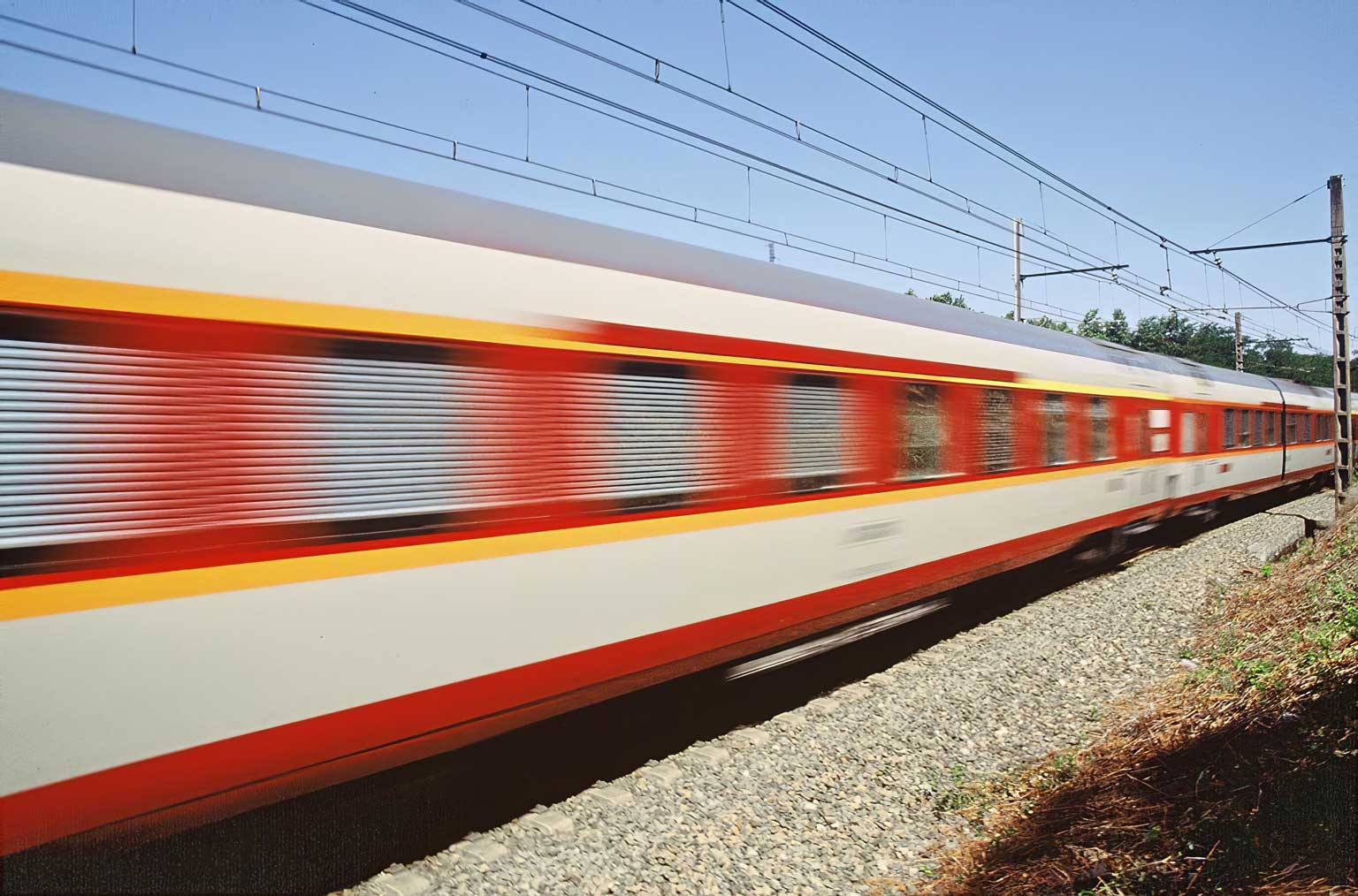
In 1970 the Capitole was upgraded to a TEE service. For that occasion completely new carriages and locomotives were introduced, also suitable for 200 kilometers per hour. They had a partly red livery that referred to the 'old' Capitole, but could also be used on other trains. The new coaches were named Grand Confort and the interior was similar to the Mistral 69 type, with comparable facilities and versions (compartment and corridor coaches and bar and dining cars). The main difference was the exterior that was not constructed from stainless steel but less expensive regular steel. The carriages also had sloping sides so they could be converted to a tilting train, which would allow for faster cornering. But this conversion was never executed.
Designer Paul Arzens fitted the Grand Confort coaches with a red-grey livery and orange stripes. He also designed the matching CC 6500 locomotive with its well-known Nez Cassé (sharp nose). The Grand Confort livery of the locomotive featured the same colors as the carriages. Arzens' goal was to create a visual unity, something that was previously only achieved with trainsets. The CC 6500 locomotive was also used for other domestic TEE trains such as the Mistral, although these did not have matching Grand Confort coaches.
Aquitaine and Stanislas
More domestic TEE services existed in the southwest of France. In 1968, L'Étendard (French for banner) was introduced with Capitole rolling stock on the Paris-Bordeaux connection. This train was added to the TEE network in 1971 with Grand Confort coaches. A 'mirror train' was also introduced on the same route: l'Aquitaine (named after the region surrounding Bordeaux).
One train left Paris for Bordeaux in the morning, the other one in the afternoon and vice versa. This way businessmen could visit one of the two cities and return home on the same day. The 584 kilometer stretch was completed in 4 hours. With an average speed of 145 km/h the Aquitaine was the fastest train in the Trans Europ Express network.
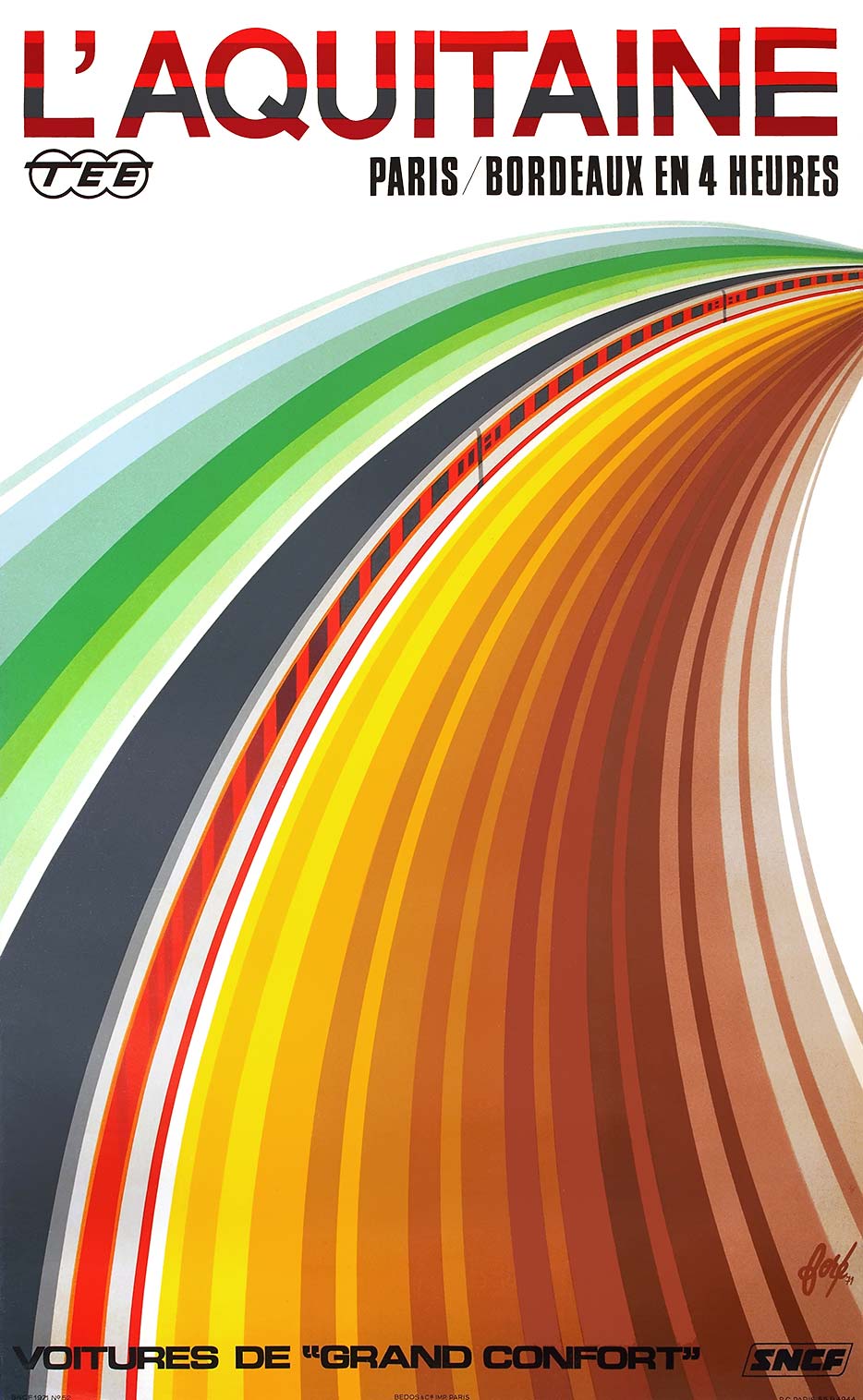
The Aquitaine poster by Foré was again using parallel stripes to catch the characteristics of the carriages, but this time the lines were curved and multicolored like a rainbow. The lettering of the train's name was also filled with colors. The same design was adapted for Le Kleber (Paris-Nancy-Strasbourg), while a version with a dark background was used for the 'mirror train' in the opposite direction in the evening: Le Stanislas.
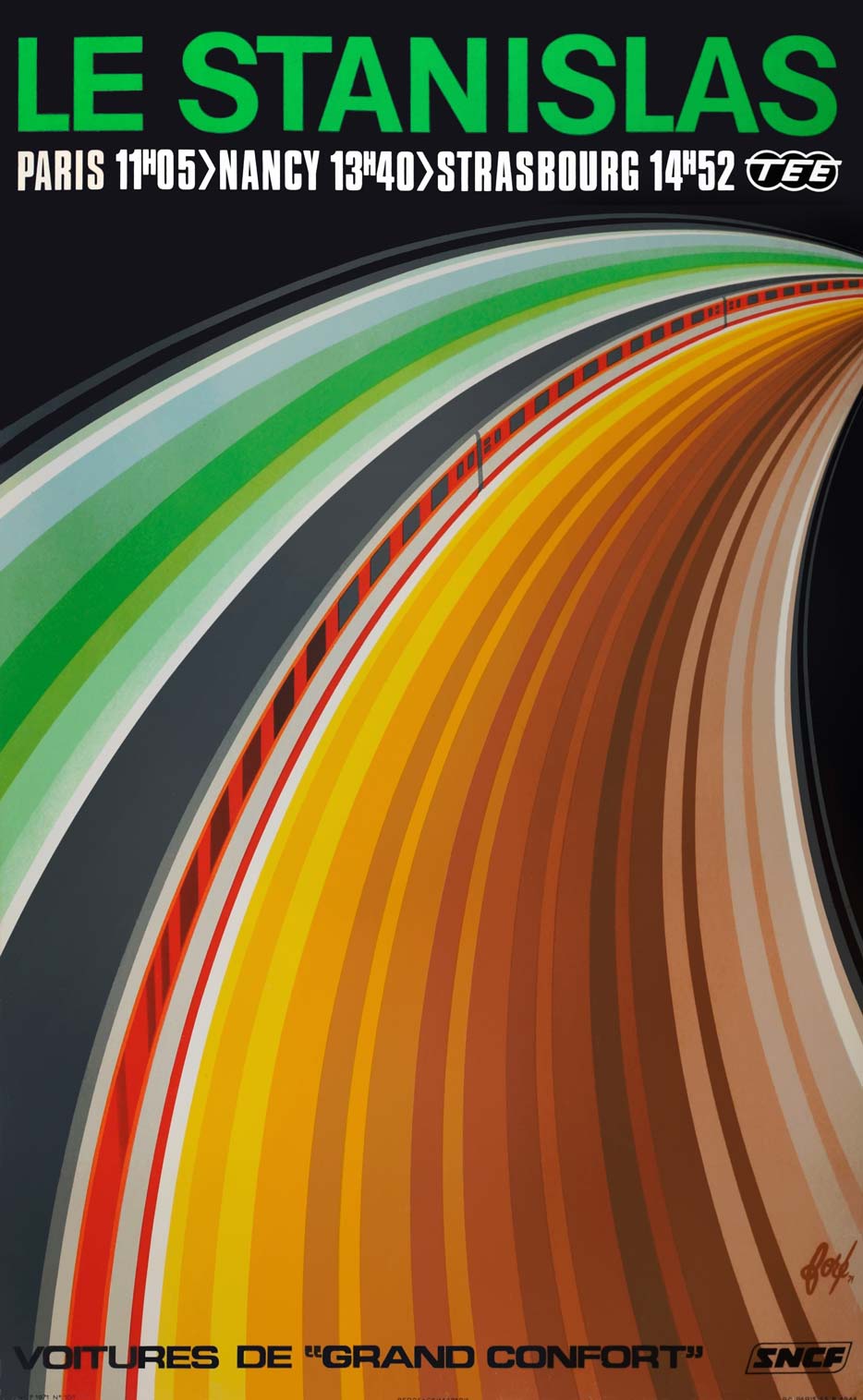
Both trains were named after historical figures from the region Alsace-Lorraine to which they connected. The Kléber bore the name of General Jean-Baptiste Kléber, Napoleon's commander of the French troops in Egypt, who was born in Strasbourg. The Stanislas was named after King Stanislaus I of Poland who became Duke of Lorraine in 1709, with Nancy as the capital. The Kleber and Stanislas were promoted to TEE trains with Grand Confort carriages in 1971.
Paul Arzens
Industrial designer Paul Arzens (1903-1990) created aerodynamically shaped experimental cars in the 1930s. From 1947 onwards he worked for the SNCF, designing the electric locomotives of the iconic BB and CC series. Besides their shape Arzens considered the livery colors of great importance, preferably matching the carriages. He conducted tests on a model railway in his workshop, painting existing model trains in different colors to get an impression of the result in a landscape.
In the early 1960s Arzens developed the CC 40100 locomotive with a tilted windshield, taking inspiration from the shape of a sprinter (runner) in a starting block. This design evolved in the slightly simplified Nez Cassé locomotives like the forementioned CC 6500.
Aftermath
.jpg)
The TEE network reached its largest extend around 1975, but soon afterwards the decline started. Aviation increased and became more affordable. TEE trains with only first class seating at a surcharge were comparatively expensive. Intercity trains with a choice between two classes were more successful. At the same time high-speed trains emerged, such as the TGV in 1981. French domestic TEEs were replaced by two-class express trains between 1976 (Le Lyonnais) and 1984 (Le Capitole). The Grand Confort carriages were partly converted into second-class coaches. They could be recognized from the outside by a green instead of orange stripe above the windows. In the end all former TEE trains in France were replaced by TGVs.
In 1975 Philippe Foré designed his last award-winning SNCF poster, titled Air Pur (clean air). It was less abstract in style, but the Grand Confort carriages were still present. In the 1970s Paul Arzens designed the Livrée Béton (light grey livery with orange trimming), but the SNCF's new flag ship - the TGV - was designed by Jacques Cooper, with the color orange prevailing.
